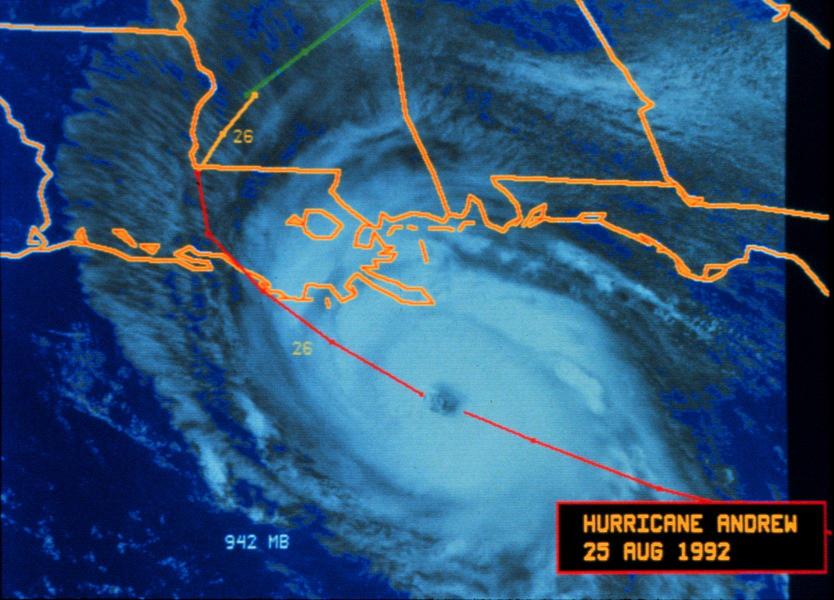Hurricane Andrew
After wreaking havoc on Florida, Hurricane Andrew made landfall in Louisiana and caused widespread devastation.

NATIONAL OCEANIC AND ATMOSPHERIC ADMINISTRATION
Hurricane Andrew.
In mid-August, the first named storm of the 1992 hurricane season formed in the Atlantic Ocean, heading westward over the Florida panhandle. Known as Andrew, the storm would go on to strike Elliott Key and then Homestead, Florida, at a Category 5, creating havoc as it killed thirty-eight people (fifteen directly and twenty-three indirectly) and left $25.3 billion in damages, making it the costliest disaster in US history to that date. Almost immediately, the National Hurricane Center announced that its name would be retired, adding further gravitas to the storm’s destruction. Then, instead of dissipating as most storms do, Andrew entered the Gulf of Mexico, regained strength, and continued its tirade of damages in a second strike to Louisiana.
As the state’s residents prepped for the storm, roughly 1.25 million central and southwest Louisiana residents tried to flee. Meanwhile, levee workers closed 111 floodgates outside New Orleans and along the Mississippi River in response to fears that the hurricane’s storm surge would overtop levees. As it approached the Louisiana coast on August 26, Andrew slowed down, dropping significant rain from Lafayette to New Orleans. It brought eight feet of storm surge along the coast and caused flooding between Vermilion Bay and Lake Borgne. As it moved further inland, it overturned cars in Franklin, ripped roofs off homes and hotels in Morgan City, and tore up beaches in Grand Isle.
In contrast, fourteen tornados ripped Ascension, Iberville, Pointe Coupee, Avoyelles, and East Baton Rouge Parishes. In LaPlace, a rare F3 tornado destroyed 163 structures in ten minutes for four and one-quarter miles. Its human impact on Louisiana was severe, with nine deaths (six directly and three indirectly) and a loss of $1 billion in property damages, with the most severe property damage in St. Mary Parish.
The storm’s environmental impact on the state was deeply devastating. The site of its barely Category 3-level landfall in Morgan City, near Marsh Island Wildlife Refuge, south of Iberia Parish, had catastrophic results for the coastal marshes. Meanwhile, fishing, oyster, and alligator industries along the coast expected a fifty percent hit to their seasonal profits, a reversal of one of the best seasons in years. In the Atchafalaya Basin and Bayou Lafourche, the storm killed 187 million freshwater fish. Furthermore, the storm’s high winds and flooding caused $289 million in damage to sugarcane fields and soybean crops.
After the storm, Louisiana and Florida lay in ruins, desperately seeking aid for rebuilding efforts. Andrew hit during a heated presidential election year. The incumbent President George H. W. Bush faced criticism for his administration’s handling of the storm’s aftermath, as the slow response by the Federal Emergency Management Agency and federal disaster relief assistance stuck firmly in voters’ minds. Nonetheless, he would go on to carry the state by 54 percent. Louisiana, whose damage was less severe than Florida but still “beyond anything we have known in recent years,” according to then-Governor Edwin Edwards, received less federal relief funding and support.
